- Goldman Sachs predicts that the creator economy will double by 2027.
- Brands have already begun shifting traditional ad dollars to creators.
- AI will help boost the creator sector, offering both new tools, and putting a premium on authenticity.
My only regret in 2023 is not seeing Taylor Swift’s “The Eras Tour” live. I did, however, go see the concert movie with my dad, more than a month after it hit AMC Theatres. For nearly three hours, I sang along in a theater still packed full with teenage girls, other 30-something women (some also with their dads), elderly couples, and families.
Much has been written about the “Taylor Swift effect,” or her ability to bring people together, get them out of the house in a post-pandemic world, and generate over $5 billion for the US economy in the process. Swift’s music and touring alone have also made her a billionaire, which is rare for an artist, and she’s Time Magazine’s “Person of the Year.”
But Swift’s success is also a lesson and a warning for established businesses. Next year, 2024, will be the start of the “creator era” of media, marketing, and commerce, and this new era has the potential to reorder the landscape even more than AI next year.
The creator era is here
Goldman Sachs estimates that the creator economy is currently worth $250 billion and will nearly double to $480 billion by 2027. For context, that’s close to the $500 billion the White House says “Bidenomics” has driven in private sector investments since 2021.
Creators are individuals who create content for digital platforms to build and monetize their audience. They are the backbone of the creator economy, an ecosystem also comprised of platforms, brands, vendors, agencies, and consumers, who exchange content, money, or goods/services.
While Swift isn’t exactly a creator – she’s a creative and a celebrity – she embodies the creator spirit: As my fellow analyst Andrew Lipsman says, “the best creators first break the mold, then they break through, and then they break the system.” In other words, creators go over the top of established institutions to market and bring products directly to their communities.
Swift has built one of the largest and most engaged fandoms, “Swifties,” and she has broken established business norms and gone direct-to-consumer in several ways: She forwent traditional tour marketing by announcing her tour through Instagram, she is re-releasing all of her studio albums with additional songs, and she bypassed studios in bringing her concert to the silver screen.
Very few creators will ever have the combination of scale, talent, and resources that Swift does, but many have communities that are strong enough to rival those of traditional brands. Their audience-first, product-second mindset has also made creators strong brand-builders, product marketers, and revenue-generators. Many already function like small businesses on social media, using their content, creativity, and personal brand to drive sales.
Smart brands have already recognized this. Spending on sponsored content on social media will rake in nearly $6 billion in 2024 in the US alone, per Insider Intelligence estimates. That doesn’t include paid amplification or creator ads in other media channels, which will propagate in 2024 as brands continue to shift budget from traditional and digital advertising to creators.
The smartest businesses know that creators could eventually become their rivals. Agencies are snapping up influencer marketing firms and hiring creators as consultants and strategists, while brands are co-creating products with creators to bring their magic in-house.
Meanwhile, the number of breakthrough creator brands is set to rise in 2024, following in the footsteps of Prime, Chamberlain Coffee, and Feastables.
AI will boost the power of the creator economy
There’s no question that AI will be transformative to business, but it won’t upend the media, marketing and commerce landscape in 2024 the way the creator economy will.
Instead, AI will deepen our reliance and relationship with existing products and services, including those that cater to creators, as the technology will be integrated into almost every tool businesses use. New, innovative AI tools will certainly emerge next year, but those, too, will primarily serve marketers as a way to boost creative effectiveness and improve efficiencies.
At the same time, consumers’ continued wariness toward generative AI will place a premium on authenticity and transparency. It’s no coincidence that in a year where everything quickly seemed to become more artificial and commoditized, Merriam-Webster chose “authentic” as its “Word of the Year.”
To be fair, 2023 was also the year of “de-influencing,” which was partly a response to recent influencer scandals, an oversaturation of sponsored content, and creators’ role in fueling overconsumption during an economic downturn.
But creators who posted de-influencing videos also understood something that many observers missed: It was a way to renew trust with their audiences.
Unlike ChatGPT, which broke through to the mainstream seemingly overnight, most top creators have now spent years building a foundation of trust among their audiences. That foundation will further bolster their power in this new era of media, marketing, and commerce.
Jasmine Enberg writes a column about social media for CMO Insider, covering the companies, creators, and internet culture. Enberg is a principal analyst at Insider Intelligence.
Read the full article here





